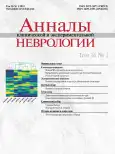Bilateral stimulation of the subthalamic nucleus under local and general anaesthesia
- Authors: Asriyants S.V.1, Tomskiy A.A.1, Gamaleya A.A.1, Poddubskaya A.A.1, Sedov A.S.2, Pronin I.N.1
-
Affiliations:
- Burdenko Neurosurgical Center
- Semenov Institute of Chemical Physics
- Issue: Vol 16, No 1 (2022)
- Pages: 46-52
- Section: Technologies
- URL: https://journals.rcsi.science/2075-5473/article/view/124081
- DOI: https://doi.org/10.54101/ACEN.2022.1.6
- ID: 124081
Cite item
Full Text
Abstract
Introduction. Bilateral stimulation of the subthalamic nucleus (STN) is successfully used to treat advanced stages of Parkinson's disease. The standard surgical technique includes microelectrode recording and intraoperative stimulation. The introduction of 3T MRI into clinical practice and new impulse sequences have led to the question of whether the surgery can be performed under general anaesthesia.
Aim of the study: to compare the efficacy and safety of bilateral stimulation of STN in patients with Parkinson's disease, using 3T MRI under local and general anaesthesia.
Materials and methods. This prospective, randomized controlled study included 40 patients, who underwent electrode implantation using 3T MRI. The patients in the main group (n = 20) had electrodes implanted under general anaesthesia, while the control group (n = 20) had local anaesthesia, intraoperative stimulation and microelectrode recording. The patients’ motor status, quality of life, cognitive function and required levodopa dose were evaluated after 6 months.
Results. The results of 6 months of stimulation were obtained from 30 patients (15 from the main group and 15 from the control group). Reduced motor impairment was observed in both groups as measured on the UPDRS III scale during the 'off' time, with a reduction of 68.7% in the main group and 74.7% in the control group. Improved quality of life, reduced drug-induced motor complications and a reduction in the levodopa dose were also comparable in both groups. No intraoperative haemorrhagic complications were recorded during the study.
Conclusions. Preliminary analysis of the data showed that with high-quality visualization of the STN, electrode implantation under anaesthesia is equally effective to awake surgery.
Full Text
##article.viewOnOriginalSite##About the authors
Svetlana V. Asriyants
Burdenko Neurosurgical Center
Author for correspondence.
Email: sasriyanc@nsi.ru
ORCID iD: 0000-0002-1821-6323
neurosurgeon
Russian Federation, MoscowAlexey A. Tomskiy
Burdenko Neurosurgical Center
Email: atomski@nsi.ru
ORCID iD: 0000-0002-2120-0146
Cand. Sci. (Med.), Head, Group of the functional neurosurgery
Russian Federation, MoscowAnna A. Gamaleya
Burdenko Neurosurgical Center
Email: agamaleya@nsi.ru
ORCID iD: 0000-0002-6412-8148
neurologist
Russian Federation, MoscowAnna A. Poddubskaya
Burdenko Neurosurgical Center
Email: apoddubskaya@nsi.ru
ORCID iD: 0000-0002-5776-3442
neurologist
Russian Federation, MoscowAlexey S. Sedov
Semenov Institute of Chemical Physics
Email: alexeys.sedov@gmail.com
ORCID iD: 0000-0003-3885-2578
Cand. Sci. (Biol.), Head, Human cell neurophysiology laboratory
Russian Federation, MoscowIgor N. Pronin
Burdenko Neurosurgical Center
Email: pronin@nsi.ru
ORCID iD: 0000-0002-4480-0275
D. Sci. (Med.), Professor, Full member of RAS, Head, Radiology department, Deputy director for scientific work
Russian Federation, MoscowReferences
- Weaver F., Follett K., Hur K. et al. Deep brain stimulation in Parkinson disease: a metaanalysis of patient outcomes. J Neurosurg. 2005;103(6):956–967. doi: 10.3171/jns.2005.103.6.0956. PMID: 16381181.
- Mansouri A., Taslimi S., Badhiwala J.H. et al. Deep brain stimulation for Parkinson’s disease: meta-analysis of results of randomized trials at varying lengths of follow-up. J Neurosurg. 2018;128(4):1199–1213. doi: 10.3171/2016.11.JNS16715. PMID: 28665252.
- Kerl H.U., Gerigk L., Pechlivanis I. et al. The subthalamic nucleus at 3.0 Tesla: choice of optimal sequence and orientation for deep brain stimulation using a standard installation protocol: clinical article. J Neurosurg. 2012;117(6):1155–1165. doi: 10.3171/2012.8.JNS111930. PMID: 23039154.
- Cheng C.H., Huang H.M., Lin H.L., Chiou S.M. 1.5T versus 3T MRI for targeting subthalamic nucleus for deep brain stimulation. Br J Neurosurg. 2014;28(4):467–470. doi: 10.3109/02688697.2013.854312. PMID: 24191703.
- Longhi M., Ricciardi G., Tommasi G. et al. The role of 3T magnetic resonance imaging for targeting the human subthalamic nucleus in deep brain stimulation for Parkinson disease. J Neurol Surg A Cent Eur Neurosurg. 2015;76(3):181–189. doi: 10.1055/s-0033-1354749. PMID: 25764475.
- Chandran A.S., Bynevelt M., Lind C.R. Magnetic resonance imaging of the subthalamic nucleus for deep brain stimulation. J Neurosurg. 2016;124(1):96–105. doi: 10.3171/2015.1.JNS142066. PMID: 26295914.
- Ho A.L., Ali R., Connolly I.D. et al. Awake versus asleep deep brain stimulation for Parkinson’s disease: a critical comparison and meta-analysis. J Neurol Neurosurg Psychiatry. 2018;89(7):687–691. doi: 10.1136/jnnp-2016-314500. PMID: 28250028.
- Chen T., Mirzadeh Z., Chapple K.M. et al. Clinical outcomes following awake and asleep deep brain stimulation for Parkinson disease. J Neurosurg. 2018;130(1):109–120. doi: 10.3171/2017.8.JNS17883. PMID: 29547091.
- Engelhardt J., Caire F., Damon-Perrière N. et al. A phase 2 randomized trial of asleep versus awake subthalamic nucleus deep brain stimulation for Parkinson’s disease. Stereotact Funct Neurosurg. 2021;99(3):230–240. doi: 10.1159/000511424. PMID: 33254172.
- Tsai S.T., Chen T.Y., Lin S.H., Chen S.Y. Five-year clinical outcomes of local versus general anesthesia deep brain stimulation for Parkinson’s disease. Parkinsons Dis. 2019;2019:5676345. doi: 10.1155/2019/5676345. PMID: 30800263. [Erratum in Parkinsons Dis. 2019;2019:2654204. PMID: 31827761].
- Sheshadri V., Rowland N.C., Mehta J. et al. Comparison of general and local anesthesia for deep brain stimulator insertion: a systematic review. Can J Neurol Sci. 2017;44(6):697–704. doi: 10.1017/cjn.2017.224. PMID: 28920562.
- Yin Z., Luo Y., Jin Y. et al. Is awake physiological confirmation necessary for DBS treatment of Parkinson’s disease today? A comparison of intraoperative imaging, physiology, and physiology imaging-guided DBS in the past decade. Brain Stimul. 2019;12(4):893–900. doi: 10.1016/j.brs.2019.03.006. PMID: 30876883.
- Liu Z., He S., Li L. General anesthesia versus local anesthesia for deep brain stimulation in Parkinson’s disease: a meta-analysis. Stereotact Funct Neurosurg. 2019;97(5–6):381–390. doi: 10.1159/000505079. PMID: 31962310.
Supplementary files








